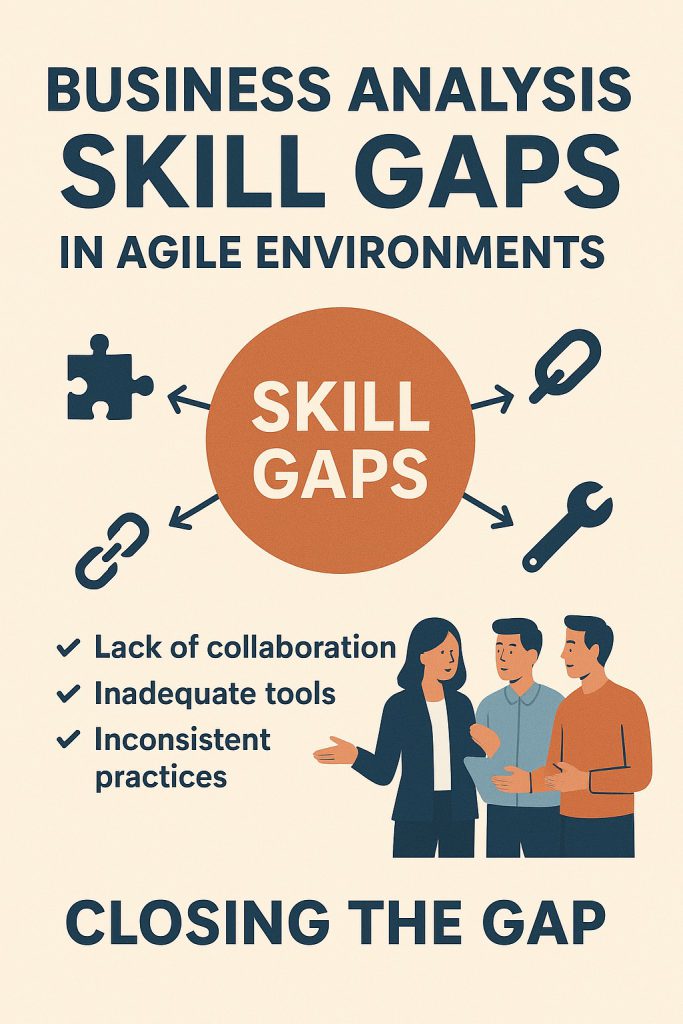Agile has changed the way organizations deliver value. From software development to business transformation, Agile promises faster delivery, adaptability, and customer-centric outcomes. Yet, behind the stand-ups, sprints, and backlogs, there’s a crucial role often overlooked — the Business Analyst (BA).
For decades, Business Analysts thrived in structured environments where requirements were carefully gathered, documented, and signed off before projects began. In Agile, however, requirements evolve, priorities shift, and collaboration replaces documentation. This shift has highlighted a challenge many organizations now face: Business Analysis skill gaps in Agile environments.
The Role of Business Analysis in Agile
There’s a common misconception that Agile frameworks like Scrum have replaced the need for Business Analysts. After all, Agile emphasizes the roles of Product Owner, Scrum Master, and development teams. But if we look closely, the responsibilities of a BA — clarifying business needs, ensuring stakeholder alignment, and translating requirements into actionable solutions — are still critical.
The difference is that in Agile, the BA role is less about writing documents and more about enabling collaboration, refining user stories, and ensuring business value is delivered sprint after sprint. Unfortunately, many BAs haven’t fully adapted to this new expectation, creating gaps between what Agile needs and what traditional BA skills provide.
Key Business Analysis Skill Gaps in Agile
Value-Driven Thinking
In traditional environments, success often meant delivering requirements as written. In Agile, the focus shifts from outputs to outcomes. It’s no longer enough to ask “What should we build?” The real question is “Why are we building this? What value will it create?” Many Business Analysts still struggle to frame work in terms of business outcomes rather than just features.
Collaboration and Facilitation
Agile thrives on constant communication between stakeholders, product owners, and delivery teams. But for BAs trained to work independently on documentation-heavy processes, this level of collaboration can feel overwhelming. Skills like facilitation, conflict resolution, and guiding stakeholder workshops are often underdeveloped — yet they’re vital in Agile.
Backlog Refinement and Prioritization
Backlog management is central to Agile, and while Product Owners are accountable, Business Analysts play an important supporting role. Writing effective user stories, ensuring clarity, and applying prioritization frameworks like MoSCoW or WSJF requires a skillset many BAs are still developing. Without these skills, teams risk bloated backlogs filled with low-value items.
Adapting Requirements Practices
Traditional requirements gathering produced lengthy specifications. Agile calls for lightweight, iterative requirements — user stories, acceptance criteria, prototypes, and continuous feedback. Many BAs still err on the side of over-documentation, slowing down Agile delivery instead of enabling it.
Technical and Domain Awareness
In cross-functional Agile teams, BAs need at least a working understanding of technical practices, data flows, APIs, and testing. While they don’t need to code, they do need to understand enough to have meaningful conversations with developers and testers. This technical fluency is still missing in many business analysis skillsets.
Measuring Outcomes
Agile is about delivering value — but how do you measure that value? Business Analysts often lack experience in using Agile metrics, KPIs, and OKRs to track whether delivered features actually drive business success. Without this skill, teams risk celebrating activity instead of outcomes.
Why Closing the Gap Matters
If Business Analysts can’t evolve, Agile teams suffer. Features get built without solving real business problems. Backlogs fill with noise instead of value. Stakeholders get frustrated, and delivery teams lose focus. In short, Agile without effective business analysis turns into speed without direction.
The solution isn’t to phase out BAs but to empower them with the right Agile skills. Organizations that recognize this and invest in closing these gaps are the ones that see Agile truly transform their business.
Bridging the Gap: How Business Analysts Can Adapt
Business Analysts can thrive in Agile — but it requires a mindset shift and continuous learning. Here’s how:
Think outcomes, not outputs. Always tie requirements to business goals and customer needs.
Master collaboration. Invest in facilitation skills, user story mapping, and stakeholder alignment techniques.
Get comfortable with Agile tools. Jira, Azure DevOps, and Trello aren’t just for tracking tasks; they’re tools for creating clarity.
Balance documentation. Learn the art of “just enough” requirements — enough to guide, not enough to slow down.
Build technical fluency. You don’t need to code, but understanding APIs, data models, and testing practices adds huge value.
Measure success. Learn to link user stories to business outcomes using OKRs and Agile KPIs.
Final Thoughts
Agile is not just a methodology; it’s a cultural shift. And Business Analysts are central to ensuring that shift delivers real business outcomes. The skill gaps we see today aren’t weaknesses — they’re opportunities. Opportunities for BAs to redefine their role, embrace agility, and become value champions in their organizations.
The organizations that succeed in Agile will be the ones that recognize the importance of strong business analysis and invest in developing these skills. The question is not whether Agile needs Business Analysts — it’s whether Business Analysts are ready to embrace Agile.
👉 Ready to upskill and close the gap?
At ScrumConsult, we specialize in equipping professionals with the tools, techniques, and mindset to thrive in Agile environments. From Business Analysis in Agile to Scrum, OKRs, and Lean Six Sigma, our training programs are designed to help you stay relevant, competitive, and future-ready.
📌 Visit scrumconsult.com
today and take the next step toward becoming an Agile-savvy Business Analyst.

